With every CPU generation, we cover we have a SKU list and value analysis piece. Now that the second generation Intel Xeon Scalable CPUs, codenamed “Cascade Lake”, is released, we wanted to share this analysis with our readers. One can clearly see the impacts of increased competition with AMD EPYC at certain bands, especially in the lower cost tiers. There are some SKUs where Intel made major moves in this generation while others saw very modest clock speed increases.
Introduction
When the first generation, codenamed “Skylake-SP”, was launched, we did our standard Intel Xeon Scalable Processor Family SKUs and Value Analysis. Given how similar the new chips are, and the fact that they are socket compatible with a BIOS upgrade, we are going to separate our analysis into three parts:
- Sharing the source Intel document
- Looking at the second generation Intel Xeon Scalable SKU stack
- Comparing the first and second generation Intel Xeon Scalable SKU stacks
Number 3 on that list is new this year. We wanted to go through a comparison exercise. Many organizations will continue to buy the first generation, while new projects will likely be completed with the second generation parts. To that end, we wanted to show where in the SKU stack you may want to consider changing generations.
Official Source Second Generation Intel Xeon Scalable SKU List
We were sent three slides with the SKU list. The first slide is the decoder ring for the new SKUs:
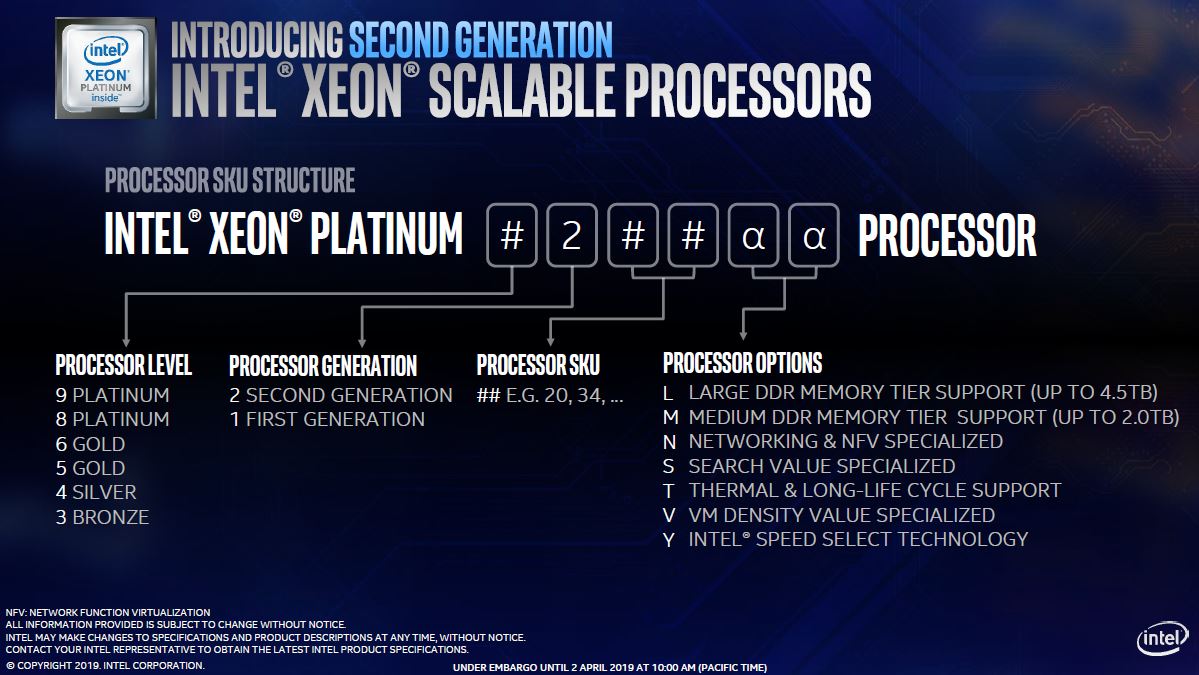
One will notice that Intel considers the Platinum 9200 series to be a natural succession of this line, even though it is not socketed, not socket compatible, and limited in scope.
With this generation, the “M” SKUs now have support up to 2TB of DDR4 memory up from 1.5TB in the first generation. There is a new “L” tier for higher memory configurations going up to 4.5TB.
“F” SKUs with Intel Omni-Path have been removed. They were a great value if you wanted to use Omni-Path 100Gbps fabric, but we found they did not work in every server. We had many server vendors want to test their servers with our Intel Xeon Gold 6148F parts, but after several asked to, getting the OPA cables from the SKUs to the backplane always proved to be difficult for smaller installations.
Here is the full SKU list from Intel:
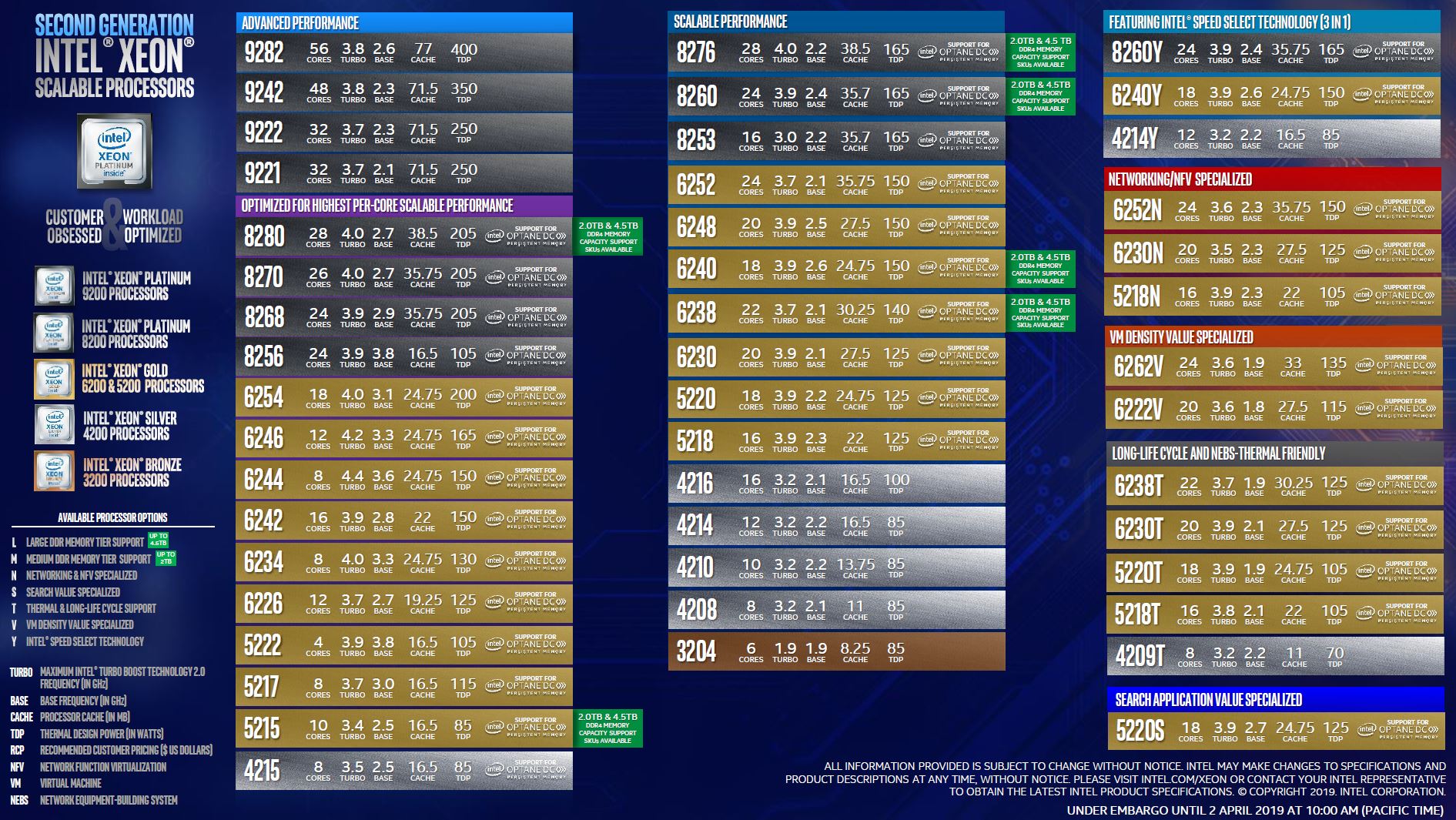
Here is the SKU list with pricing:
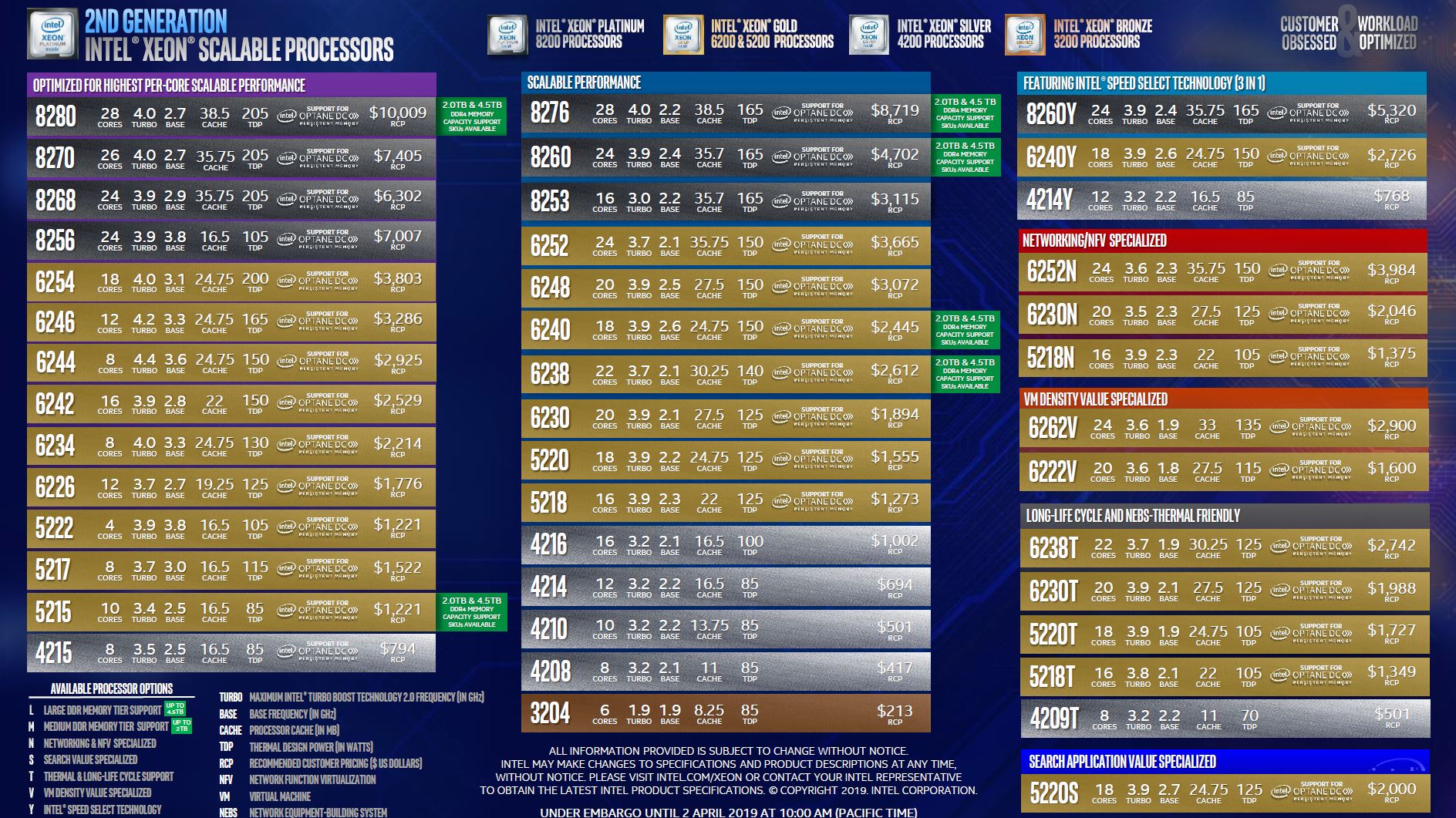
A few notes here:
- The Intel Xeon Platinum 8256 we believe is incorrectly labeled as a 24 core part. Given the cache size price and segment, this should be a 4 core part like the Platinum 8156.
- M and L SKUs are strategically missing from the pricing slides
- Platinum 9200 SKUs are strategically missing from the pricing chart
With that said, let us get to our analysis based on the above.
Looking at the Second Generation Intel Xeon Scalable Stack
Here is the full stack transcribed, likely with a few typos, from the official charts. For the SKUs we had pricing on, or excluding the M, L, and Platinum 9200 series, we have the relative pricing and how many cores * clock speed you get for each dollar spent.
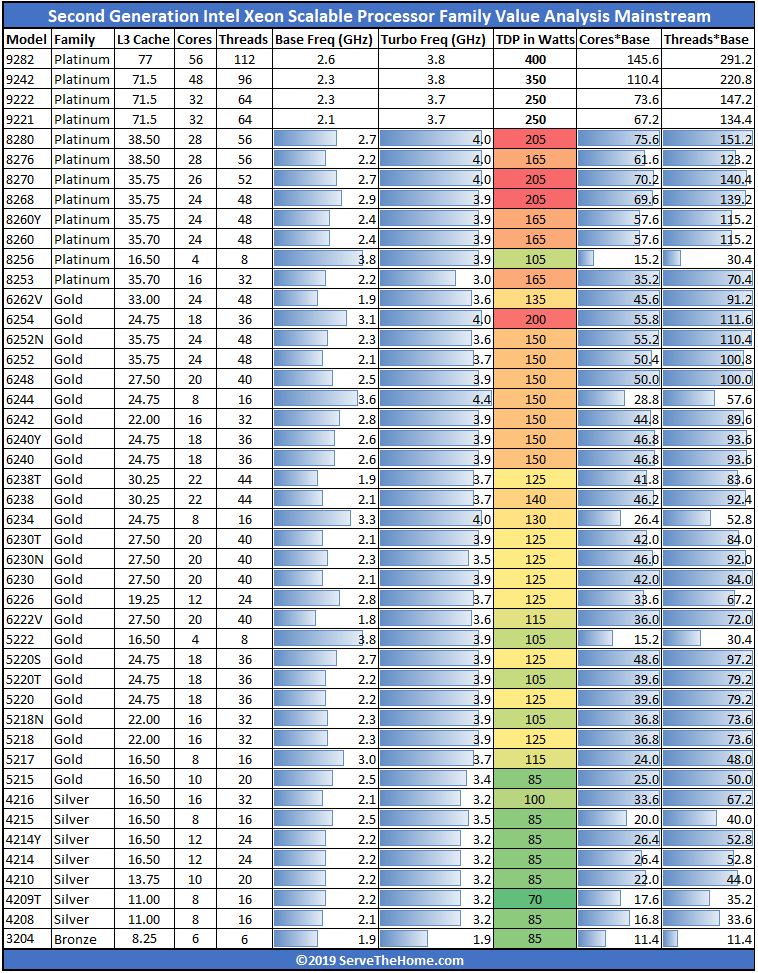
Making this even more relevant, we pulled the NVYST set out and here is the SKU stack:
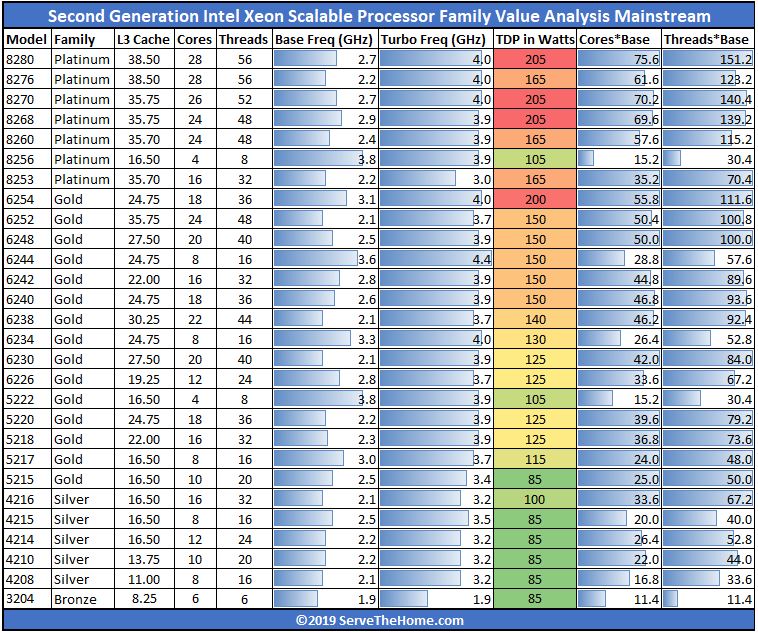
One can see pricing is about what it was in the previous generation. One can also see a clear trend showing how its core performance optimized SKUs are priced higher. These SKUs are utilized to lower licensing costs by using fewer higher-clocked cores. As a result, Intel is extracting value here. Likewise, there is a significant premium for M and L parts. When one adds tens of thousands of dollars of memory to a system, Intel uses the M and L parts to extract a higher chip price as well.
We took the N, V, Y, S, and T series SKUs and put them in the following chart to simply show what they have going for them. As a fun aside, internally we call this the NVYST set pronounced like: “invest.”

We were slightly surprised to see that, in general, these were the better value portions of the SKU stack. In hindsight, it makes sense because Intel is not targeting per-core licensing scenarios here.
On the next page, we are going to show the differences between the first and second generation Intel Xeon Scalable processor families in generational value analysis.

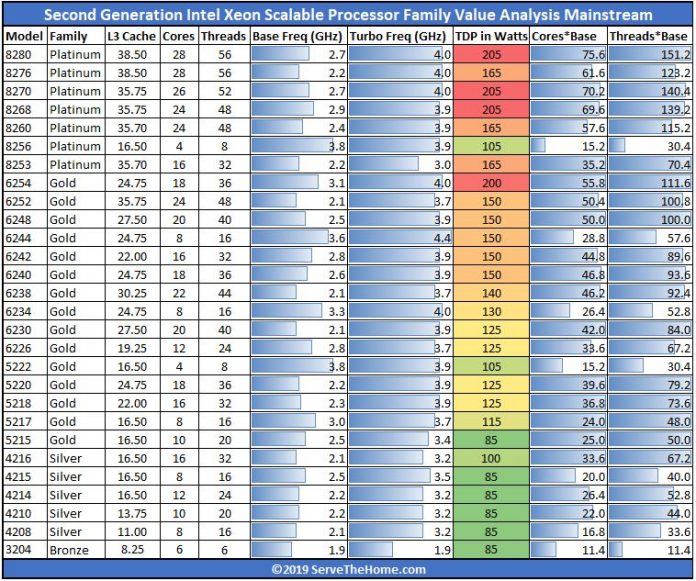



Interesting. Our cpu of choice was 6136 with two cores per dram channel, full cache, relatively high frequency and still sensible price. There is (currently?) simply no comparable option among 62xx offers. I wonder if there will be more SKUs in the near future …
In your comparison table your 6252 base clock freq. is incorrect – as far as I know it is a 2.1GHz part not 2.5GHz, which seems to be the same as the Intel slides. Boost is correct though.
Just waiting for ours to arrive with a new Dell R740 test box. Interested to see how it performs with LoginVSI and generally with our VDI workloads, we will also be running the same tests with the 6254 part.
> Based on our testing, Intel may have added dual port FMA AVX-512 to this line.
Not according to intel ARK.
> One can also see a clear trend showing how its core performance optimized SKUs are priced higher. These SKUs are utilized to lower licensing costs by using fewer higher-clocked cores.
It’s surprising to me that software vendors haven’t changed their licensing terms. If there’s one thing these guys are good at it’s shaking down their captive audience.
Nils, we covered the AVX-512 bit in our note. It may have been the QS chip we were using. Need to re-test that one.
On software licensing, we have a piece that has been sitting in our publishing queue for a month going live this weekend.
Two first tables are missing cost and cost related columns?
Weird, that 3204 part could very well have fit in a much lower TDP, 45W perhaps. Any particular reason why Intel would set its envelope as high as 85W? I wonder if that’s the bare-minimum for the FCLGA 3647 platform.
THANK PATRICK! as usual, your site (and forums) helped me save quite a bit! (in reality, get more cpu for my money, more so than spend less).
specifically- this article and your excellent chart. I had picked out a 1st gen scalable that i was ready to buy qty 4x of (picked sku through my own chart/comparison of the skus), i then remembered/found this article though your chart was able to easily see that the 2nd gen Silver 4210 would actually be a better value for our usecase. It ended up being A TAD LOWER in price vs my pick, AND we got 2x more cores at the same base/turbo frequencies + newer gen, (and ofcouse higher multi and single threaded passmark scores!)
thanks again
(i dont have my original pick in-front of me, but i think it was the 4108, maybe and im getting/basing prices on this particular clients servers build from ebay)
Is it possible to download a copy of your spreadsheet? Many of these are readily available used on eBay at this point and would be nice to compare used prices with your calculations.